Egypt's Journey Through Colonization: The Lasting Impact of Ottoman and British Rule on a Nation's Development

Photo: Wikipedia Commons
By: Rania Basria | Arab America Contributing Writer
Egypt’s strategic location at the crossroads of Africa, Asia, and Europe has made it a prized possession for many rulers throughout history. This unique location, along with the lush Nile River Valley and old cultural legacy, drew conquerors and colonists looking to control its resources and trade routes. Arab America contributing writer, Rania Basria, examines two of Egypt’s most significant eras of foreign rule: the Ottoman and British occupations. These two eras left indelible traces on Egypt’s political, social, and economic environment, influencing the country’s growth in significant and long-lasting ways
The Ottoman Empire, which spanned Southeast Europe, the Middle East, and North Africa, conquered Egypt in the early 16th century. During this time, Egypt was integrated into a greater Islamic empire, mixing local customs with Ottoman administrative methods and cultural influences. For centuries, Egypt served as an important province within this vast empire, contributing to its economy while enjoying varied degrees of autonomy and central supervision.
However, the start of the modern age brought new difficulties and power upheavals. The growth of European imperialism and the drive for worldwide control sparked greater foreign interest in Egypt, culminating in the British occupation in the late 1800s. The British largely considered Egypt as a gateway to the East, particularly when the Suez Canal was built, which considerably reduced sea connections between Europe and Asia. Their occupation, which lasted until the mid-twentieth century, was characterized by economic exploitation, infrastructure improvements, and a growing nationalist movement among Egyptians seeking independence.
This article delves into the history of Egypt’s colonization by the Ottomans and the British, exploring the administrative structures, economic policies, social changes, and lasting effect of these two separate but overlapping eras of foreign authority. Understanding these historical circumstances allows us to get insight into Egypt’s complicated route to modernity and autonomy.
The Ottoman Empire established dominance over Egypt in 1517, when Sultan Selim I destroyed the Mamluk Sultanate at the Battle of Ridanieh. This victory signaled Egypt’s admission into the huge Ottoman empire. Initially, Egypt preserved some autonomy under Ottoman rule, with local Mamluk beys (provincial rulers) wielding considerable influence.
The Ottomans established a complicated administrative structure in Egypt, blending local control with administration from Istanbul. The governor (wali) was appointed to administer the government, while Mamluk beys handled local matters. This dual system frequently resulted in power battles, but it provided a sense of continuity in government.
Egypt was economically crucial to the Ottoman Empire. It functioned as an important link between the East and West, supporting commercial routes across the Red Sea and the Mediterranean. Egypt’s agricultural resources, notably cotton and grain, were critical for the empire’s survival. However, hefty taxes and resource exploitation caused economic hardship and resentment among the Egyptian people.
Culturally, the Ottoman period saw the fusion of Turkish, Arabic, and Islamic elements. Cairo, a famous center of Islamic study, continued to thrive. The Ottomans constructed several mosques, schools, and public works, contributing to Egypt’s architectural and cultural legacy. However, the adoption of Ottoman Turkish as the governmental language ended up isolating the Arabic-speaking majority.
Socially, Ottoman power upheld the Mamluks’ hierarchical structure, with a clear divide between governing elites and the general population. This stratification frequently resulted in societal tensions and revolutions, as shown in several revolts over the years.
The 18th century saw an increase in European interest in Egypt. The short French invasion led by Napoleon Bonaparte in 1798 highlighted Egypt’s strategic importance to European nations. Despite the French withdrawal in 1801, their rule left an indelible mark. It emphasized Egypt’s fragility and usefulness as a gateway to Asia and Africa.
Following the French departure, Muhammad Ali Pasha, an Albanian general in the Ottoman army, rose to prominence. When he was appointed governor of Egypt in 1805, he launched a series of ambitious reforms aimed at modernizing the country. He reformed the military, rebuilt infrastructure, and encouraged agricultural and industrial growth. Muhammad Ali’s activities considerably increased Egypt’s autonomy inside the Ottoman Empire, paving the way for future dealings with European powers.
The British occupation of Egypt started in 1882, following the Anglo-Egyptian War. Their involvement was primarily meant to stabilize the country during internal upheaval and defend their financial interests. This notably included the Suez Canal, a vital maritime route connecting the Mediterranean and Red Seas.
The British created a disguised protectorate over Egypt, preserving the appearance of Ottoman power but exerting de facto authority. Lord Cromer, the British consul-general, conducted broad administrative changes that prioritized economic stability and infrastructure development. However, these reforms were essentially for British economic gain, frequently at the cost of the Egyptian people.
Economically, the British escalated their exploitation of Egypt’s resources. They increased cotton farming to feed British textile factories, resulting in monoculture and reliance on a single crop. This emphasis on cotton weakened conventional agriculture and created economic weaknesses.
Another notable British project was the construction of the Aswan Low Dam in 1902, which was designed to regulate the flow of the Nile and improve irrigation. While it increased agricultural output, it also had environmental and social consequences, displacing people and changing traditional farming techniques.
Socially, British control accentuated existing disparities. The aristocracy, which included both Egyptians and Europeans, grew from the economic improvements, while most Egyptians experienced poverty and marginalization. Nationalist feelings intensified, resulting in the emergence of movements advocating independence and self-government.
Egypt’s vigorous nationalism movement emerged in the early twentieth century. Saad Zaghloul’s Wafd Party rose to prominence as an advocate for independence. The 1919 Egyptian Revolution was a watershed moment, with massive protests against British control. The movement drew worldwide attention, prompting the British to grant Egypt nominal independence in 1922, but maintaining control over critical areas such as military and foreign affairs.
The 1952 Free Officers’ Movement, led by Gamal Abdel Nasser, eventually overthrew the monarchy and ended British influence in Egypt. Later, the withdrawal of British troops in 1956 marked the end of Egypt’s long struggle for independence.
Egypt had enormous administrative, economic, and social changes throughout Ottoman and British control. While the Ottomans established a sophisticated administration structure and promoted cultural growth, the British rule resulted in economic exploitation and heightened nationalist feelings. Both eras left permanent imprints on Egypt’s historical trajectory, affecting its road to modernity and independence. Understanding this history is critical for understanding the problems and goals that have defined contemporary Egypt.
Check out our Blog here!








